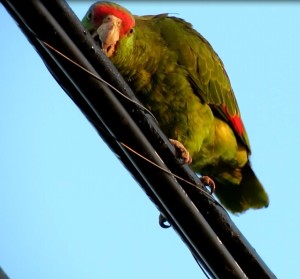There is no doubt on anyone’s mind that the survival of these birds is sustained by the varied food sources available. The fruit, nectar, flower buds, and sometimes bark, of imported landscaping plants make up the bulk of their diets.
The availability of most of these seasonally consumed foods are not year around. The variety and concentration of these imported plants make finding easier for these parrots. For this reason, our parrots typically prefer urban settlements to our natural ecological areas. In these urban areas, some species such as Indian Ringnecks, Nanday Conures and possibly Blue Crowned Conures routinely frequent household bird feeders.
While less common, there are also accounts of Mitred Conures, Red Crowned, and Lilac Crowned Amazons who also frequent birdfeeders in Southern California as well. With many food and vitamin sources available, the diets of these parrots are anything but basic. We have documented and photographed over sixty food items to date. A photo gallery link will soon be provided with these foods and their referenced plant names on this site as well.
While we know that exotic and imported flora are the preferred diet choice among California parrots, we also know that the origins of many consumed exotic plants such as African Wild Plum (Harpephyllum Caffrum), or Cape Chestnut (Calodendrum capense) are not found in their native ranges. So how did they learn what to eat?
In their settler days, this possibly may have originated with either a trial and error phase. This may have also possibly have been accomplished by following other bird species such as Crows and Band Tailed Pigeons which currently share many food items with these parrots. Today’s flock members appear to have it much easier.
From young ages, fledglings stay close to their flock where various adults feed them. This helps them associate a tree’s appearance with food. Later, a fledglings parents will leave their own young for a few hours in a specified, non-toxic tree to better acquaint these juveniles with foraging behavior and its edible contents. While these curious fledglings chew on everything in sight, they learn to familiarize themselves with what’s food and what’s not.
While adult parrots may rely on a flock’s loud communicating calls to help guide them to food, this may also include recognizing the distinct calls of other parrot species which also share a majority of the same seasonal diet.

Hydration methods are also unique among various parrot species in California. While Indian Ringnecks and Nanday Conures may at times be observed at ground level taking drinks from water basins, this behavior has never been witnessed among our state’s larger Amazons nor Mitred Conures despite our triple digit hot summer temperatures. Instead, these parrots have possibly adopted alternate methods for hydration.
One observed method of hydration involved by a Red Crowned amazon using lower beak to accumulate and scoop morning dew from the top of a utility power line. Other flocks of Amazons have been observed often repeatedly chewing various juice filled fruits and palm fronds which they later discard after juices were extracted.
Another occurrence involved an Almond tree which was commonly frequented by three White Fronted Amazons (Amazona Albifrons). After finding numerous discarded yet still intact almonds at its base, I’ve witnessed that each almond had a similar punctured hole created by the parrot’s beak. As these parrots routinely returned to this tree for nearly a week to repeat this behavior, It is later believed that the consumed juice found in the almond was the actual reason for these repeated arrivals.
Predators and threats of adult parrots may include Cooper’s Hawks, Red Tailed Hawks, and Peregrine Falcons. The eggs and nestlings may succumb to Fox Squirrels, Brown rats, feral cats, Virginian Opossums, Raccoons and bee colonization at nesting sites. However, despite the numerous possible threats to these parrots, their greatest threat is man. As perceived threats these intelligent animals have developed defenses for humans as well.
While feeding in trees, at least one wary flock member will always keep watch of all pedestrian activity below. This member will immediately sound an alarm if a curious passerby pauses nearby for too long or even makes prolonged eye contact. This alarm is followed by a simultaneous flight. While the alarm call may be distinctive among species, these diverse alarms are easily interpreted by all parrots and often induces reactions from other flock species nearby.
Unlike human presence which is carefully watched by the parrots prior to taking flight, the presence of any large bird of prey will result in an immediate flight upon sight.
Furthermore, like many animal species, certain Amazon parrot species may become more protective when young are present. As loving parents with fledglings exposed in trees, several adults have been observed flying at high speeds while at only a few meters off the ground. It is during this period that many curious onlookers may experience what appears to be a fast flying parrot almost crashing into them.
It is believed that this behavior is used by adults and designed to discourage the overly curious interests of any potential threats to their offspring and of course, we humans are no exception in this case. However, it is important to note that this activity is considered harmless to any human onlooker as no physical contact is ever made by any parrot. This behavior has been only exhibited by adult parrots in large flocks while fledglings were present.

